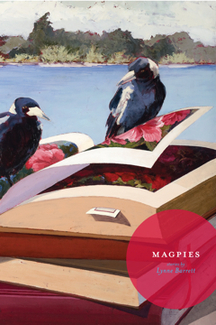On Magpies: Part Three of a Four-Part Interview with Lynne Barrett
 Part One of my interview with Lynne Barrett is here, and Part Two is here.
Part One of my interview with Lynne Barrett is here, and Part Two is here.
If you want to meet Lynne, she will be reading from and discussing Magpies at the Miami Book Fair as part of a panel with Tayari Jones (Silver Sparrow), Ana Menendez (Adios, Happy Homeland) and Justin Torres (We The Animals) on Sunday, Nov. 20, 12:30 p.m., in Room 3209, (Building 3, Second Floor), Miami Dade College, Wolfson Campus.
And now, Part Three:
Angela: At your Books and Books reading, John Dufresne introduced you as “The Empress of Plot” because of your beloved and popular FIU classes on Plot. How does your theoretical understanding of what’s necessary for a good plot inform your writing of one?
Lynne: In the class, I teach plot not as formula but as a set of concepts that can help a writer through the morass of inventing, revising, and structuring. It’s there not to constrict but to encourage students to make their stories stronger, and of course I do try to listen to myself (though I don’t always obey, any more than the students do). To me study of plot, story, and structure is analogous to studying dance or acrobatics or other such training: you will feel self-conscious as you learn the moves, but then as you get stronger you are freed to play and you can do things you wouldn’t have been able to before. That’s certainly how it’s been for me. I know that sooner or later I’m going to have to make it all hang together, but that doesn’t mean I don’t make a mess as I’m drafting and wondering how this can all possibly work out. Sometimes I get a structural idea and see if I can pull it off, very much like using a form in poetry, but the goal is to make something that dances.
Angela: Is suspense necessary to good plot(ting)? In all of the stories here, even those that might not be considered “suspense,” there is an element of anxiety. I’ve typed the first lines of some stories here:
“Links”
“Language this,” Avery said, the first day I worked at eBrightlights.com.
“One Hippopotamus”
Lightning: I wake to the flash, see Carlos’s clothes, the surface of a man thrown over the chair.
“Gossip and the Toad”
Tally McTeer left the Bubble Room and headed homeward, thinking through the last tidbits she’d call in for her column.
“The Noir Boudoir”
On a warm Tuesday morning in late October, the tail end of the hurricane season, I sit in my car outside the Delphi and pretend I’m on a stakeout: a honed tedium.
“When, He Wondered”
Maybe it was at the Fenwicks’ playoff party in January, when Tom went to the kitchen for a beer, and Elise came up behind him as he turned in the cold exhale of the refrigerator.
“Cave of the Winds”
Azalea, Barry, Caterina, Darryl—three Tropical Storms and a Category One—formed off Africa in July and meandered into the North Atlantic without harming anyone, but their arrival started up the jitters.
In almost all of them, you generate some anxiety in the title and the first line. How is that important to your sense of what makes a good story, what makes good storytelling?
Lynne: At the start of a story, I want to generate anticipation, which is central to suspense. Even the anticipation of pleasure has some potential for anxiety, because pleasure carries risk both that it won’t work out right and that, if it’s wonderful, it will soon slip away.
I don’t usually write the first line first—I often write a lot finding my way to it, and I inevitably revise, and re-revise, the beginning in light of the end and middle. Looking at these examples, I see many things I was doing. There’s often some kind of orienting detail about where we are and who we’re with. We need to know a little something to build anticipation on. As readers, we grasp onto those first bits of information and begin, immediately, to imagine what this story might be, knowing also that the story can (and should) turn in surprising ways. But those “facts” are combined are other things which the reader may not consciously notice at the time which pay off later. So, for example, “Links” starts with Avery giving the narrator an order, in the imperative, in what turns out to be his style of short, brusque, idiosyncratic sentences. While I wouldn’t say that suspense is evident at the start, to me “first day of work” carries a hint of anxiety, and getting an order like that does, too. But the command turns out to have other layers of meaning as she “languages” the whole story for us. At the same time “e.Brightlights.com” may sound like fun, or possibly satire, and there’s also the fact that the reader can see, before that first line, a section header which is another command Enter Here in blue and underlined. That’s the first of the “links” of the title, and from it, ideally, the reader is picking up the fact that there is something usual about the story’s structure and, I hope, finding that intriguing. So even in this short space there are layers to what’s being opened up.
The start of “The Noir Boudoir” invokes the tedium of a stakeout, which may seem very quiet for a story that’s about multiple murders. But “honed tedium” isn’t the same as boredom, is it? Something about “honed” says more than that to me. I wanted to get across fast that the narrator is a former cop (now antique dealer, as we soon learn), and his experience and ability to patiently persist are part of what will make him the right guy to solve things.
On the other hand, if there were an “anxiety score” we could give to the lines, I’d say that the opening of “One Hippopotamus” has a lot, in its glimpse of “the surface of a man.” That’s a relationship story. This goes back to my answer to your genre question: relationships of all sorts are full of anxiety and mystery, I think. All trust carries risk. For that matter, what do we know about ourselves? “When, He Wondered,” with a question implied in its title and that “Maybe” at the start, setting up uncertainty, is very much about Tom discovering what he’s capable of.
Can’t say more! I want the reader to be anxious to read the stories.
Tomorrow: Part 4, for writers.





1 Comment
wholly jeanne
I’m one who loves to learn the rules so I can break them intelligently. And these are great first lines – they do, indeed, create just enough tension, just enough anxiousness, just enough uncertainty to make me want to read more.